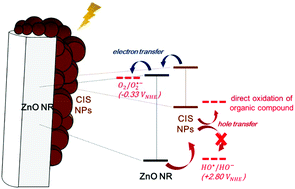Environmentally benign synthesis of CuInS2/ZnO heteronanorods: visible light activated photocatalysis of organic pollutant/bacteria and study of its mechanism†
Abstract
Due to its high light absorption coefficient and appropriate bandgap, CuInS2 (CIS) has been receiving much attention as an absorber material for thin film solar cells and also as a visible light photocatalyst. Herein we present heterostructured CIS/ZnO nanorods (NRs) in an attempt to enhance light absorption and facilitate charge separation/transfer in the photocatalysis system. CIS nanoparticles (NPs) were directly deposited on ZnO nanorod arrays (NRAs) to fabricate heterostructured CIS/ZnO NRAs using an environmentally benign, non-hydrazine solution reaction. These heterostructured NRAs are immobilized on FTO glass, which has additional merits of recyclability and bias-applicability. The ideal type-II band structure of CIS/ZnO enables efficient charge separation/transfer, which is confirmed by PL (photoluminescence) decay measurements. Also, the 1D-ZnO NR structure facilitates fast charge transfer along with enhancing light absorption via light scattering. These synergistic effects improved the photocatalytic activity in both organic dye and bacteria decomposition. The photodecomposition efficiency was further enhanced with an aid of external bias. The underlying photocatalytic mechanism was also investigated through controlled experiments under various scavenging conditions. The results suggest that reactive oxygen species (ROS) formed by multistep reduction of O2 play a main role in photocatalysis, while hole-induced photodecomposition is relatively deactivated due to the band structure of the heterostructures of CIS/ZnO.



 Please wait while we load your content...
Please wait while we load your content...